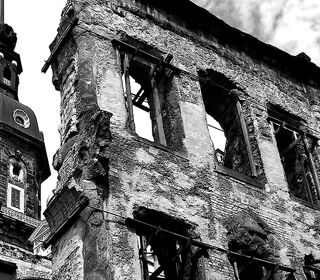
Blog Article

How does conservation factor into rebuild and repair after war and conflict? Researchers at BCU analyse 'reconstruction era' cities and how those decisions shape cities 70 years later.
Researchers
- Peter Larkham
- David Adams (University of Birmingham)
Research background
Today’s cities have been substantially reshaped during the post-war period, and even those not bombed jumped on the replanning bandwagon. New infrastructure such as ring roads, new architectural forms and materials, and new land uses such as shopping centres all emerged from this short period. 70 years later we are also beginning to assess whether any of these merit retention and conservation and recently the research has been questioning how such decisions are made.
Research aims
The research sought to explain the nature and extent of destruction and the processes and products of replanning and rebuilding that have shaped today’s urban areas.
Research methods
The research has involved identifying, and content analysis of, the post-war reconstruction plans (about 250 of which are known), supported by detailed archival research in the National Archives at Kew, and regional and local archives. This has identified was the ideal reconstruction was; and what processes – and even individuals – reshaped those ideas into what was actually built. Surveys of individual cities have identified the scale and nature of the rebuilding, and its impact on area function and character. Some interviews with surviving individuals, ranging from architects to those who lived through the destruction and reconstruction, have provided added evidence of process and impact.
Results
The research has revealed an unexpectedly high number of reconstruction plans, and emphasised that – contrary to the impression given in the planning history literature – the majority of these were produced by the local authorities themselves, rather than the well-known, eminent and expensive consultants. Nevertheless, some of the consultants’ plans remain embedded in local consciousness (Thomas Sharp’s plan for Chichester, for example).
The nature and timing of what was created were shaped by factors ranging from the lack of building materials and central government funding to the influence of local politics and even powerful individual decision-makers. The “reconstruction-era” infrastructure, in particular, still shapes cities 70 years later, although in a very few cases (e.g. Birmingham) this expensive investment has already been superseded.
Some of these buildings were innovative and designed by significant architects. In other circumstances, they may be worthy of preservation. But their architectural style is often unpopular with the public and decision-makers and few are conserved; the same is true for the wider reconstruction areas. Only in 2019 for example, after much controversy, was Plymouth city centre, the most iconic of the rebuilt central areas, designated as a conservation area.
Outputs
The research has produced a number of academic chapters and papers focusing on individual towns and cities, and several comparative papers. Provocative short pieces on the conservation-worthiness of buildings and areas of this period have been published by organisations such as the Institute of Historic Building Conservation and Royal Town Planning Institute. A public lecture for Gresham College (London) is available on youtube and has generated over 15,000 views (https://www.youtube.com/watch?v=0q6mWmg2b1Q). Peter has advised several documentary production companies and appeared (briefly) on a Channel 4 documentary on reconstruction in London.
Key publications
-
Larkham, P.J. (2020) ‘Bombed churches, war memorials and the changing English urban landscape’, Change over Time vol. 9 no. 1 pp. 48-71
-
Larkham, P.J. (2020) ‘British reconstruction planning after the Second World War: the rise of planning and the issue of “non-planning” ’, Architectúra & Urbanizmus issue 1/2 pp. 16-27
- Adams, D. and Larkham, P.J. (2019) The Everyday Experiences of Reconstruction and Regeneration: From Vision to Reality in Birmingham and Coventry Routledge, Abingdon
- Larkham, P.J. (2019) ‘Bombing and rebuilding’, Context (Institute of Historic Building Conservation) no. 160 pp. 23-26
- Larkham, P.J. and Adams, D. (2018) ‘Originality and authenticity in the post-war reconstruction of Britain’, in Bold, J., Larkham, P.J. and Pickard, R. (eds) Authentic reconstruction: authenticity, architecture and the built heritage, Bloomsbury, London
- Larkham, P.J. (2018) ‘Coventry: a model of modernist reconstruction’, in Fischer, K.F. and Altrock, U. (eds) Windows upon planning history Routledge, Abingdon
- Larkham, P.J. (2018) ‘Planning in Britain during and immediately after the Second World war: planners, processes and plans’, Storia Urbana no. 158 pp. 35-59 (theme issue: ‘Britain at war: damages, debates, reconstruction during and after the Second World War’)
- Larkham, P.J. (2016) ‘Replanning post-war Birmingham: process, product and longevity’, Architectura vol. 46 pp. 2-26 (theme issue on European postwar reconstruction)
- Pendlebury, J., Erten, E. and Larkham, P.J. (eds) (2014) Alternative visions of post-war reconstruction: creating the modern townscape Routledge, London
- Larkham, P.J. (2013) ‘Visions for a new Birmingham’, in Larkham, P.J. (ed.) Bournville Village Trust When we build again Routledge, Abingdon
- Clapson, M. and Larkham, P.J. (eds) (2013) The Blitz and its legacy: wartime destruction to post-war reconstruction Ashgate, Farnham